#House Painting Services Suffolk
Text
All Pro Painting Co.: Top-Rated House Painting Services in Suffolk County
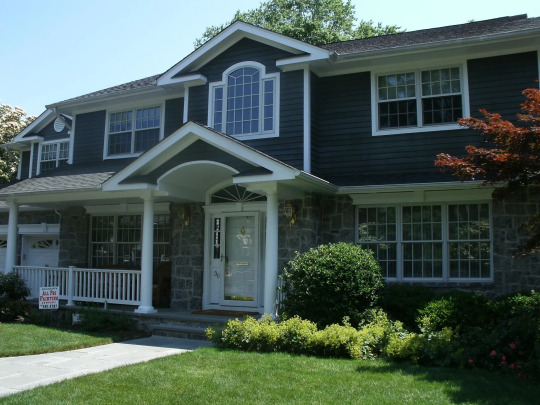
Enhance Your Dwelling with Expert House Painting Services in Suffolk
Your abode mirrors your unique personality and style, and what better method to augment its allure than with a fresh layer of paint? If you're a delighted homeowner residing in the picturesque Suffolk region, you're in for a treat! All Pro Painting Co. offers premium house painting services that will breathe new vitality into your living spaces. With our team of adept professionals committed to excellence and precision, we're here to metamorphose your house into a breathtaking masterpiece that you'll take pride in calling home
The Craft of House Painting: Uplift Your Suffolk Home
Your dwelling transcends mere brick and mortar; it's an empty canvas yearning for adornment. Our house painting services in Suffolk are customized to elevate the aesthetic allure of your residence. Boasting an extensive palette of colors, finishes, and techniques, we collaborate closely with you to grasp your vision and convert your house into a work of art.
Revealing the Enchantment: House Painting Services in the Heart of Suffolk
Nestled in the heart of Suffolk, All Pro Painting Co. stands as a paragon of quality and craftsmanship. Our house painting services are devised to emphasize your home's intrinsic charm, all while providing a shield from the elements. Whether your objective is to revitalize the exterior or inject a burst of vibrancy into your interior spaces, our team guarantees a seamless application that leaves an enduring impression.
The All Pro Painting Co. Distinction: Excellence in Every Brushstroke
What distinguishes All Pro Painting Co. is our steadfast commitment to perfection. Our house painters are not merely skilled laborers; they are artists driven by an unyielding aspiration for flawlessness. From meticulous surface groundwork to the deft handling of brushes, we invest our unwavering dedication into every brushstroke, delivering outcomes that outstrip your anticipations.
Revamp Your Abode: From Dreary to Dazzling with All Pro Painting Co.
Is your Suffolk domicile yearning for a revamp? Search no further than our house painting services to morph your home from lackluster to lustrous. Our adept painters grasp the subtleties of color psychology and design aesthetics, ensuring that your house transforms into a harmonious and inviting haven for you and your cherished ones.

Trusted Expertise: Leading House Painting Services in Suffolk
In the realm of house painting, experience reigns supreme. All Pro Painting Co. boasts a well-established legacy of serving the Suffolk community with pride. Our many years of proficiency have equipped us with the dexterity to address an array of painting conundrums, rendering us the first choice for homeowners seeking reliable and top-notch house painting services.
In Conclusion
Your abode is your sanctum, and All Pro Painting Co. is here to elevate its allure and grace. Fueled by a fervor for imagination and an unwavering commitment to excellence, our house painting services in Suffolk are tailored to exceed your anticipations. Bid adieu to humdrum walls and usher in a realm of vibrant hues and sophistication. Connect with us today at https://www.allpropaintingco.com/ to inaugurate a transformative expedition with All Pro Painting Co.

📍 : 575 Hempstead Turnpike, West Hempstead, NY 11552
📞 : (516) 481-2787
#House Painting Services Suffolk#House Painting Services hempstead#Professional Painters Suffolk County#Exterior Painting Company Suffolk County
2 notes
·
View notes
Text



#House Painting Services hempstead#Interior Painting Services Babylon#Wallpaper Installation Nassau#House Painting Services Suffolk#Professional Painters Suffolk County
2 notes
·
View notes
Text
House Washing Ipswich
Keep your home and garden pristine with professional house washing. Clean surfaces add curb appeal and protect the integrity of exterior materials, extending their lifespan.
Spore-bearing bacteria and airborne pollutants eat away at the surface of paint, causing unsightly dark streaks. Regular cleaning eliminates these streaks, protecting your investment and keeping your family healthy. To know more about House Washing Ipswich, visit the A Clean House Washing website or call 0419778863.
The outside of your home is constantly under attack from dirt, grime, airborne pollutants and mildew. These spore-bearing bacteria and particles can leave dark streaks on your property’s surfaces, detracting from curb appeal and potentially weakening the structural integrity of your home over time.
Spotless windows can make a huge difference to the look and feel of your home. They can also help to protect the health of your family by reducing the amount of dust mites and mould spores that enter your living spaces.
Getting your gutters cleaned by a house washing Ipswich company is another important part of keeping the exterior of your home clean. A clean gutter system allows rainwater to flow away from the structure of your home and prevents it from damaging the paint, siding, roof or other components of your property.
Whether you’re looking to sell or just want to enjoy your home for the time you have it, a clean exterior makes a good impression. It also preserves the condition of your property over time. Regular cleaning of driveways, patios, fences and retaining walls helps prevent dirt buildup that damages and detracts from your property’s curb appeal.
Our humid Ipswich weather creates the perfect environment for spore-bearing bacteria to develop those dark streaks that mar the appearance of your home (Gloeocapsa Magma). These contaminates not only destroy your curb appeal, but they weaken the condition of your property over time.
A high pressure washer can blast away these contaminates. However, using the wrong water PSI levels could damage your property’s surfaces and lead to expensive repairs. Our specialised Suffolk house washing and roof cleaning soft wash services eliminate these harmful organic growths using low to moderate water pressures. We also use eco-friendly and biodegradable cleaners to remove mill glaze from timber decking, which protects the wood when it’s stored in lumberyards.
Dirty exterior surfaces compromise your curb appeal and damage the condition of your home. Mildew, mould and airborne contaminants such as dust, pollen and pet stains need to be professionally removed. This is not possible with just washing or scrubbing and requires professional power cleaning. But traditional pressure washing can cause serious damage if incorrect water PSI levels are used. It can crack sidings, damage window frames and even kill plants around your home.
The best way to restore the appearance of your vinyl exterior surfaces and other materials is soft washing. Our soft wash technique uses low pressure to avoid damaging your surfaces and detergent based cleaners that leave the surface clean.
Regularly soft washed external surfaces will make your paint appear two to three shades brighter, instantly improving your curb appeal and restoring its original colour. A clean exterior also helps protect the health and well-being of your family. Eliminating mildew, mold and other organic growths can prevent them from growing back and causing allergy-related problems.
Our humid Ipswich weather creates the ideal environment for those unsightly dark streaks on roofs, caused by spore-bearing bacteria called Gloeocapsa Magma. Not only do these stains look unappealing, they also compromise the quality and longevity of your roof and reduce curb appeal. Regular professional cleaning will keep your roof in pristine condition and prevent leaks, cracks and deterioration of the surface.
A dirty exterior not only damages the appearance of your home, it can also affect your family’s health by causing respiratory issues. Mould and mildew spores can trigger allergies and asthma in children and sensitive adults, especially if they are exposed to them over extended periods of time. To know more about House Washing Ipswich, visit the A Clean House Washing website or call 0419778863.
Professional bond cleaning experts can restore your home’s external surfaces back to their original pristine condition. By using varying water pressure levels depending on the type of surface, they can safely and effectively remove dirt, grime, mould and mildew stains without causing any damage. A clean surface will also prolong the life of your home’s paint, preventing it from chipping and peeling.
#house washing#high pressure cleaning#high pressure cleaning ipswich#home washing#pressure cleaning#house washing ipswich#house exterior cleaning#home washing ipswich#exterior cleaning#house exterior cleaning ipswich#fence cleaning ipswich#tennis court cleaning ipswich
0 notes
Text
Artistry at its Best: Face Painter Suffolk County NY
When it comes to creating unforgettable moments for your special events in Suffolk County, NY, you need more than just a bouncy house with balloons. You need an artistic touch that can elevate the ambiance and enchant your guests. That's where Go Glamour 360's exceptional services come into play, providing you with a perfect blend of fun and artistry.
Face Painter Suffolk County NY:
Our talented face painters at Go Glamour 360 are masters of their craft, turning the canvas of your face into a work of art. Whether it's a birthday party, corporate event, or a community fair, our Face Painter Suffolk County NY can transform children and adults alike into whimsical characters, fierce superheroes, or dazzling butterflies. With non-toxic, hypoallergenic paints and an array of designs to choose from, the smiles on your guests' faces will be as vibrant as the artwork.

Bouncy House with Balloons Suffolk County NY:
Adding a Bouncy House with Balloons Suffolk County NY to your event is a surefire way to make it a memorable experience. Our bouncy houses are not just inflatable fun; they're a safe and exciting adventure for kids and a source of delight for adults. Paired with our balloon decor, your event space will be transformed into a colorful wonderland, setting the stage for unforgettable moments.
Balloon Decor Suffolk County NY:
Our balloon decor experts understand the power of balloons to create a festive atmosphere. From elegant balloon arches to whimsical balloon bouquets, we tailor our designs to suit your event's theme and style. Our Balloon Decor Suffolk County NY will captivate your guests and provide a vibrant backdrop for photos and memories.
At Go Glamour 360, we pride ourselves on infusing artistry into every facet of your event. Our face painters, bouncy houses with balloons, and balloon decor are designed to bring joy, laughter, and creativity to your gatherings. Contact us today to make your event truly magical. Let us turn your vision into a reality that your guests will cherish for years to come.
#Face Painter Suffolk County NY#Bouncy House with Balloons Suffolk County NY#Balloon Decor Suffolk County NY
0 notes
Text
The Benefits of Renting Apartments with Green and Sustainable Features
In the hustle and bustle of urban living, finding a home that not only caters to our needs but also aligns with our environmental values is a gratifying experience. As a professional content writer with over a decade of experience in the field, I understand the importance of making informed decisions when it comes to choosing a living space. In this blog post, we will explore the myriad benefits of renting apartments with green and sustainable features, particularly in the vibrant Lower East Side neighborhood and the sought-after Suffolk apartments for rent. By the end of this article, you'll discover why eco-conscious apartment living is not just a trend but a wise and responsible choice.

Lower Environmental Footprint:
One of the most compelling advantages of renting green apartments is the reduction in environmental impact. These eco-friendly buildings are designed to minimize energy consumption, conserve water, and reduce waste. From energy-efficient appliances and LED lighting to water-saving fixtures, each element contributes to a lower carbon footprint. By opting for apartments in Lower East Side or Suffolk apartments for rent with green features, you actively participate in the global effort to combat climate change.
Energy and Cost Savings:
Sustainable apartments are not only kind to the environment but also friendly to your wallet. Advanced insulation, double-glazed windows, and energy-efficient HVAC systems ensure lower utility bills. As a tenant, you'll enjoy cost savings on electricity and water consumption without compromising on comfort and convenience.
Healthier Living Spaces:
Green apartments prioritize indoor air quality, employing ventilation systems that bring in fresh air while filtering out pollutants and allergens. The use of low-VOC (volatile organic compound) materials in paints and flooring further enhances indoor air quality. These features promote healthier living spaces, reducing the risk of respiratory issues and allergies.
Access to Green Amenities:
Many eco-conscious apartment complexes offer green amenities that enrich residents' lives. Rooftop gardens, community composting areas, and rainwater harvesting systems are just a few examples of eco-friendly amenities that encourage sustainable living and community engagement.
Integration with Public Transportation:
Apartments in the Lower East Side and Suffolk apartments for rent with green features often boast convenient access to public transportation. Proximity to bus stops, subway stations, and bike-sharing services reduces the reliance on personal vehicles, promoting eco-friendly commuting and reducing traffic congestion.
Community Engagement and Social Responsibility:
Renting an apartment in a green building fosters a sense of community and social responsibility. Green-minded residents often come together to organize eco-initiatives, such as community clean-up events, recycling drives, and educational workshops on sustainability. Living in such a community can be inspiring and fulfilling, as you work together towards a more sustainable future.
LEED and Green Certifications:
Many eco-friendly apartment buildings obtain certifications like LEED (Leadership in Energy and Environmental Design) or other green building certifications. Renting an apartment with such a designation ensures that the property adheres to strict sustainability standards, giving you confidence in your choice of living space.
Aesthetic Appeal:
Contrary to the notion that green buildings lack style, eco-friendly apartments often exhibit modern and innovative architecture. The integration of sustainable materials and eco-conscious design elements adds to the aesthetic appeal of these residences.
Long-Term Value:
As environmental consciousness grows, so does the demand for green living spaces. Renting an apartment with green features positions you at the forefront of a significant housing trend, enhancing the property's long-term value and marketability.
Contributing to Sustainable Development:
By choosing apartments in Lower East Side or Suffolk apartments for rent with green and sustainable features, you become an active participant in the sustainable development of your city. Your decision to support eco-friendly initiatives encourages developers to prioritize environmentally responsible building practices.
Conclusion:
Renting an apartment with green and sustainable features is a decision that goes beyond personal comfort and convenience. By choosing eco-friendly living spaces in the Lower East Side or Suffolk apartments for rent, you contribute to a healthier planet, save on energy costs, and become part of a community committed to sustainability. Embrace the benefits of green living and make a positive impact on both your lifestyle and the environment. Remember, every step towards sustainability counts, and your choice to rent a green apartment is a step in the right direction.
0 notes
Text

The Mary Rose (part 1)
The new Mary Rose museum at Portsmouth Historic Dockyard has been built only yards from the site where Henry VIII's flagship was built on the mudflats next to the naval yard in 1509. It is next door to the navy's oldest serving ship, Nelson's flagship HMS Victory, which is only half the age.
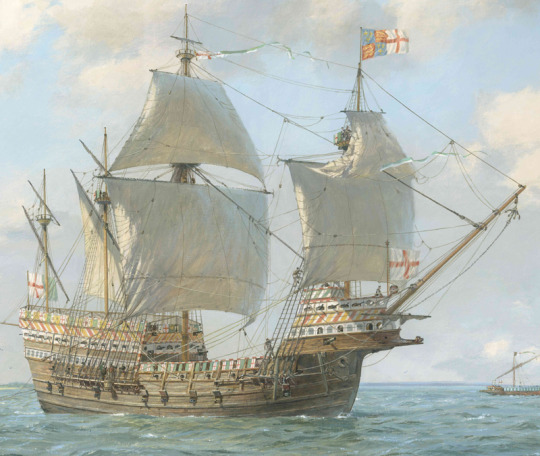
Mary Rose painting by Geoff Hunt.
Launched in 1511, the Mary Rose was intended to be the flagship of King Henry VIII's fleet. She was a new breed of warship with purpose-built gun-ports that made her a fearsome floating fortress. But on 19 July 1545, for reasons still unknown, she sank in the Solent whilst leading 60 ships against the French. Here she stayed until 11 October 1982, when 60 million people worldwide watched the wreck being raised live on television. After the Battle of the Solent had ended, the French had withdrawn and the clean-up process had begun, work on recovering the Mary Rose was started. Even though she was quite an old ship, with 34 years behind her when she sank in 1545, she was still a valuable asset, as well as the property of the King, so Henry VIII was eager to have her re-floated and back in service as soon as possible. The Lord Admiral, John Dudley, who had commanded the English fleet at the battle and had witnessed the loss of the Mary Rose, entrusted her recovery to Southampton-based Venetian salvage operators Petre de Andreas and Symone de Maryne.

They planned to use a traditional method for recovering ships; running cables under the ship's hull, which would be pulled taut by two larger vessels (in this case, the 700-ton carracks, the Sampson and the Jesus of Lubeck), bringing the Mary Rose towards the surface so she could be moved to shallower water, where she could be emptied of her contents then pumped out, allowing her to float once more. This method was, and still is, commonly used in underwater salvage; the Swedish Vasa was raised using this technique, and more recently the cruise ship Costa Concordia was refloated in a similar manner. The original plan had to been to raise the Mary Rose on 3rd August 1545, 15 days after her loss. This should have been a simple operation; she had sunk in reasonably shallow water, with her masts protruding above sea level. Venetians were considered to be experts in the field of wreck salvage, so the Admiralty obviously had high hopes.


On 5th August, it was reported that the sails and yard arms had been brought ashore, and her masts had been secured by cables, and two days later, the Duke of Suffolk, Charles Brandon, informed the Secretary of State, William Paget, that the Mary Rose would be raised "... this afternoon or tomorrow". By 9th August, all that had been achieved was the snapping of the Mary Rose's masts, delaying the raising operation further. After six more days of effort, they had still failed to move her. On 8th December, they were paid 40 Marks (about £ 27), and were told that their services would no longer be required. This wasn't the end of the story, though, as although the Mary Rose had been given up, there was still her contents that needed recovering. There were nearly £ 2,000,000 worth of guns on board (in modern money), and when the country was short of money thanks to the King's excessive spending, that was a lot of cash to leave rusting on the sea bed. Work on the Mary Rose concluded in 1552, all the salvage work up to that date having cost £ 559 8s 7d, (around 170,000 in today"s money), and the wreck was finally abandoned. It wouldn't be until 10th June 1836 that the Mary Rose would be seen again by human eyes.
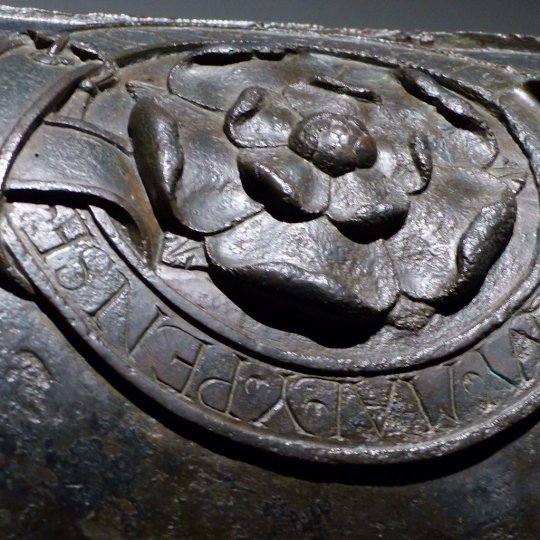
The second part of the flagship's name is believed to refer to the Tudor rose, emblem of Henry VIII's house. Mary could refer to the Virgin, but it is more commonly seen as a reference to Henry VIII's sister.
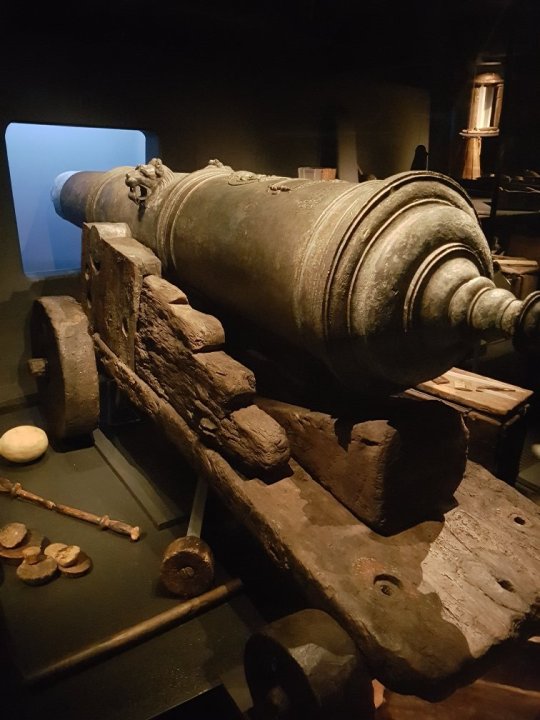

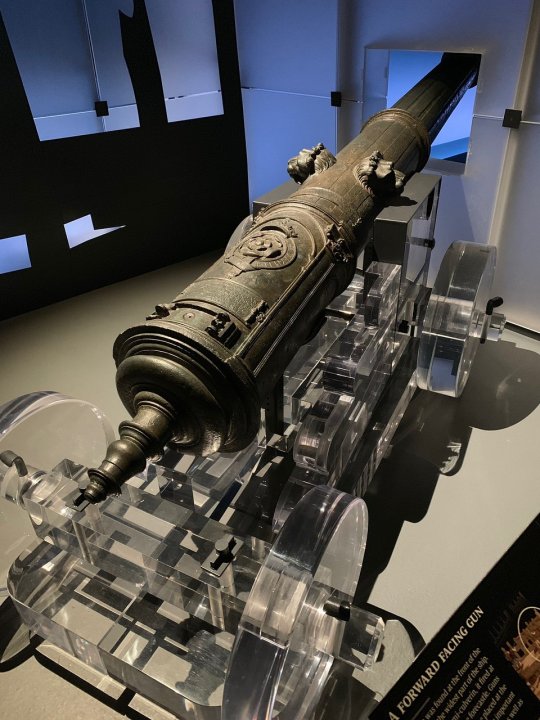
The Mary Rose represents a transition in naval history as it carried both new bronze cannons (foreground) along with wrought iron ones firing stone shots (ringed) and weapons, such as longbows and fire arrows, common in medieval warfare.
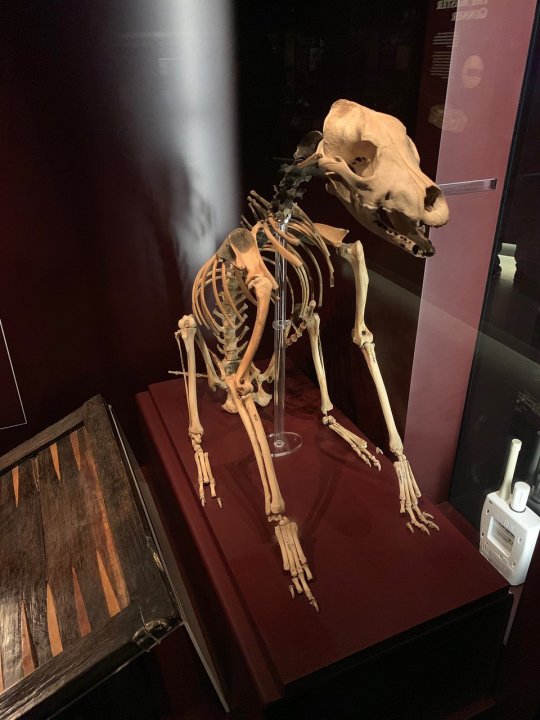
The skeleton of a healthy, young, male dog was found just by the entrance to the master carpenter's cabin. Named Hatch by museum staff, he was between 18 months and two years old, probably used for catching rats and looked like a cross between a terrier and a whippet.
#mary rose#shipwreck#british ship#king henry VIII#naval archeology#tudor rose#carrack medieval#flagship#warship#archaeological sites#artifacts#wreck recovery#16th century#history
15 notes
·
View notes
Text
Contect
Address: 1132 Tooker Ave, West Babylon, NY 11704
Phone: (516) 693-9363
Website URL
http://trustsandestate.com
About US
Estate Planning Long Island is providing a wide range of legal services. Estate Planning is the preparation of tasks that serve to manage an individual's asset base in the event of their incapacitation or death. It is a complex procedure.
The big items are obvious – houses, cars, that stunning original 1980s surrealism painting. These are the items that everyone thinks of when laying out their estate. While these items are important, they are a small fraction of a person’s estate. Dozens of smaller items, many with sentimental value, play a valuable role in one’s life so they must be considered when creating an estate plan. That old rocking chair that’s been passed down generation to generation? That’s just as important as your car. That beautiful vintage Rolex you’ve been saving for someone special? It qualifies as part of your estate.
Family conflict and disputes can arise when considering these smaller items even more so than the highly valued items. Although it can ultimately be hard to predict, if you know of any items that could cause conflict, putting clear instructions in your will saves a lot of time and heartache.
Another issue might arise with the designation of agent to control disposition of remains. New York has a document in which you may leave specific instructions concerning disposition of your remains and appoint an agent to control such disposition. This person will be in charge of your funeral and burial. If you have strong feelings and preferences concerning your funeral and burial or you want to be cremated, do not leave these instructions in your Will. Most of the time, the Will is opened and read after your funeral. Therefore, your attorney will issue the designation and leave specific instructions for your agent. Also, if you know that members of your family may argue because of your burial preferences, it is important to leave a person in charge of these decisions so that they can be made quickly and the funeral homes/director takes instructions from one designated person.
Request your Free Consultation or Call (516) 693-9363 Today!
Related Searches
estate planning lawyer | estate planning attorney | estate planning | best estate planning lawyer | best estate planning attorney | probate lawyer | probate attorney | best probate lawyer | best probate attorney| estate planning law specialist | probate law specialist | Suffolk County | NY.
GMB Listing
https://www.google.com/maps?cid=2187870077145971576
1 note
·
View note
Note
What do you think Henry VII remembers, if anything, of his other uncle Henry VI?
This is such an interesting question and something that I myself have been wondering, so thank you for providing me with the opportunity to expand my thoughts on here 🌹
We know that Henry VII only ever saw his uncle King Henry VI once during his life, when he was 13 years old. However, I’d argue King Henry must have caused quite a great impression on him, and considering Henry Tudor was old enough at that time, also a profoundly lasting one. So far young Henry Earl of Richmond had been living as a ward of his uncle Jasper’s enemies, the Herberts. By 1470 his old guardian, William Herbert, had been executed, and then, as the Earl of Warwick changed sides and brought about Henry VI’s readeption, Henry Tudor was returned to his uncle Jasper who took him to London to meet King Henry VI. That Jasper felt like acquainting his nephew with his brother denotes a special degree of closeness and advocates for his idea of family, in my opinion.
According to André, Henry VII’s court poet and self-styled regius historiographus, on 27 October 1470 Henry VI held ‘a splendid feast with the nobles and best men of the kingdom’ to commemorate his return to the throne. As the king was washing his hands, young Richmond was brought to his presence, and according to André, ‘the king prophesied that someday the boy would undertake the governance of the kingdom and would have all things under his own power.’ Polydore Vergil, a historian that began his service under Henry VII in 1506, wrote in his Three Books that in that 1470 meeting ‘the king... is reported to have said:’
“This truly, this is he unto whom both we and our adversaries must yield and give over the dominion.”
It seems not even Vergil lends much credence to this tale as expressed by his choice of words: reported to have said. As expected, this myth has largely been viewed as Tudor propaganda and indeed the episode has been immortalised in Shakespeare’s Henry VI part III. In the play, King Henry VI meets a toddler Henry Richmond (then escorted by Somerset), calls him ‘England’s hope’, and says Richmond was ‘Likely in time to bless a regal throne’. Given that King Henry VI had his own son Prince Edward as his heir at the time, it seems unlikely he would ever have said such a thing. However, if anything remotely close to that happened, then I agree with Leanda de Lisle in saying that it must have been King Henry VI taking Henry Tudor to be his own son Edward, who thanks to his imprisonment in the Tower he had not seen for five years (and would not ever see again). It’s absurdly sad to think King Henry VI would confound his nephew with his son but arguably also not out of the realm of possibility. We don’t know if Henry Tudor saw his uncle King Henry again, but it’s also not unlikely that he, his mother and uncle Jasper stayed at court for the feast of All Hallows’ (1 November) and All Souls’ Day (2 November).
If King Henry VI ever made such prophecy, wittingly or not, then it must have greatly impacted on Henry Tudor. Henry VII believed to have been chosen by God to, against all odds, become king of England. He once wrote about ‘the crown which it has pleased God to give us with the victory over our enemy at our first field’. Henry Tudor was reported to be very pious—he made pilgrimages to the shrine of St Thomas Becket at Canterbury every Easter, as well as frequent pilgrimages to the shrine of Our Lady of Walsingham and donations to the shrine of St Vincent Ferrer in Brittany. He also founded the cult of the Breton saint St Armel in England and boosted the teachings of St Francis by his patronage of the Franciscan order. He especially favoured the Observants (the Franciscans, also known as the Greyfriars), granting them annuities for the establishment of monasteries in England and abroad. It seems he also favoured staying at religious houses when travelling or going on progress around the kingdom.
Most importantly, Henry VII held a singular devotion to the Virgin Mary and his adoption of the red rose as his personal symbol—aside from dynastic reasons—had everything to do with the religious connotations of that flower. Henry VII could have associated himself with his uncle Henry VI by adopting his antelope badge, for example, but instead, he chose the five-petal flower associated with the Virgin Mary and the Passion of Christ. The Franciscans were noted for their devotion to the Passion, and Henry VII had come in contact with the Observants during his exile in Brittany. The rose had five petals like the five wounds of Christ—St Bernard of Clairvaux once stated: “As many wounds as there are on the Saviour’s body, so many roses are there! Look at His feet and His hands; do you not see roses?”
Forgive me for still going on a tangent about it, but Henry VII’s personal devotion to the Virgin Mary and the doctrine of her Immaculate Conception is exemplified in his Book of Hours, where a miniature shows a figure representing the king kneeling at a prayer desk before a vision of the Virgin as a baby held by her mother, St Anne (or, alternatively, The Virgin and the Child Jesus). His devotion to the Virgin was also highlighted in his rebuilding of the Lady Chapel (now Henry VII’s Chapel) at Westminster Abbey which I will return to in a moment.

I’m not sure but I think it was Vergil who reported Henry VII as having said that religion was his ‘continual refuge’ during exile. His piety has been largely attributed to the influence of his mother Margaret Beaufort, herself also a very pious woman. But given how many years—and formative years those were—they spent apart, I imagine that Henry must have looked up to someone closer to him at the time, namely his uncle Jasper Tudor. We know that after the death of Catherine of Valois Jasper and his brother Edmund were raised by nuns at Barking Abbey, and that then at some point they joined King Henry VI’s court. According to John Blacman, Henry VI’s biographer and chaplain writing in 1485:
[…] and like pains did [Henry VI] apply in the case of his half-brothers, the Lords Jasper and Edmund, in their boyhood and youth; providing for them most strict and safe guardianship, putting them under the care of virtuous and worthy priests, both for teaching and for right living and conversation, lest the untamed practices of youth should grow rank if they lacked any to prune them.
Blacman also claimed that the king personally protected his half-brothers from sexual temptation by keeping ‘careful watch through hidden windows of his chamber’ (yes, I know). Like his uncle King Henry VI, Henry VII would also set a court that ‘maintained the highest standards of sexual behaviour’. Indeed, Retha Warnicke made an extensive compilation of scandals during the first two Tudor reigns and not a single case of sexual misconduct was found to have taken place during Henry VII’s time, marking his court as a decidedly different one than Edward IV’s had been.
Going back to Henry VI’s supposed prophecy, his words surely must have acquired a great weight in Henry Tudor’s mind by 1483 when he made his bid to the English throne. By that time King Henry VI had become a popular saint in England and even though Edward IV had tried to have him modestly—and somewhat obscurely—buried in Chertsey Abbey, Surrey, people had started to flock to his grave. A peasant claimed that Henry VI helped him when he had a bean trapped in his ear, which only popped out after he prayed to the king. Painted images of King Henry VI began showing up in churches around the country, like this one at Barton in Norfolk:

One of King Henry VI’s most ardent devotees was Henry Tudor’s mother Margaret Beaufort (Jasper’s feelings towards the cult are unknown) who had met her kinsman when she was about nine years old. When King Henry VI allegedly offered her the option of remaining married to Suffolk’s son or be remarried to his brother Edmund, Margaret says St Nicholas came to her in a dream dressed as a bishop, telling her to choose Edmund. Again, if this story is true or not, we may never know, but Margaret told that to her confessor John (bishop, then saint) Fisher—why would a famously pious woman such as Margaret Beaufort lie to her own confessor, thus committing a sin? It might be that the events took a mystical turn in Margaret’s imagination as a young girl, but that she associated divine intervention to hers and her son’s fate, and likewise to King Henry VI’s proposal, is clear.
It seems Richard III tried to control King Henry VI’s ever-growing cult by moving Henry VI’s body from Chertsey Abbey to St George’s Chapel at Windsor, a place where visitors wouldn’t have easy access to the king. Nevertheless, when Henry VII came to the throne he wholeheartedly encouraged pilgrimages to the place. Henry VII launched an official campaign to have his uncle canonised, with several petitions to popes Innocent VIII, Alexander VI and Julius II. Henry also ordered the compilation of a book of miracles worked by his uncle, and a biography of Henry VI was published in 1500 claiming that Henry VI had been ever pious and chaste during his life, towards his queen never behaving ‘unseemly ... but with all conjugal honesty and gravity’. Henry VII planned to have the body of King Henry VI re-interred at the heart of the new Lady Chapel he was planning at Westminster Abbey.
However much Henry VII enjoyed good relations with the papacy, especially Pope Innocent VIII, his campaign to have his uncle King Henry VI canonised never came into fruition. Henry VII decided for him and his wife to be buried at his new Lady Chapel instead, next to the tomb of his grandmother Queen Catherine of Valois. In his will, he stated his wish for his body to be buried:
“in the Chapell where our said graunt Dame laye buried, the which Chapell we have begoune to buylde of newe, in the honour of our blessed Lady.”
That doesn’t mean Henry VII set aside the memory of his uncle King Henry VI. He employed the same man that was overseeing the construction of the Lady Chapel at Westminster, Reginald Bray, to continue the rebuilding of St George’s Chapel at Windsor set in motion by his predecessor Edward IV (it came to be informally known as the Bray Chapel). The modest thirteenth-century chapel of Edward the Confessor was expanded into a vast cathedral-like chapel where, importantly, Henry VI’s body was placed alongside a famous relic, the fragment of the True Cross (a reliquary known as the Cross of Gneth) and the bones of John Schorne (revered for curing gout and toothache).
We may argue that Henry VII’s campaign to have King Henry VI’s canonised was fundamentally political (much like Richard II’s campaign for Edward II) as many historians have done. King Henry VI as a saint, combined with his supposed prophecy, would successfully contribute to the image of Henry VII’s reign as one chosen by God. When we put Henry VII’s religious devotion into perspective, though, his efforts to have ‘the glorious King Henry’ canonised take another dimension—in fact, there’s no doubt that in Henry VII’s eyes God had intervened in his favour. Henry VII’s will also stated his wish for an image of himself to be placed in St Edward’s chapel at Westminster, depicting him returning to God and the Virgin Mary the circlet with which he had been crowned at the Battle of Bosworth.
This is me purely speculating, but I think that even though Henry VII only came in contact with King Henry VI once in his life, his half-uncle might have exercised a great influence on him through his uncle Jasper. Jasper seemed to have been genuinely attached to his brother Henry on a personal level as well as devoted to his political cause. If Henry VI’s saintly qualities had been enough to impress Margaret Beaufort, it is very likely that they might have impressed young Henry of Richmond as well.
48 notes
·
View notes
Text
How To Pick The Best Garage Door
How to Find the Best Garage Door
If you want to maximize the value of your home, you'll find garage doors are an easy and affordable method to increase your home's curb appeal. A good garage door will distinguish it from the rest of the neighborhood. For something extra special, custom made garage doors can be designed to your specifications.
The most common types of garage doors are: Retractable, Canopy Side, and Hinged Sectional Retractable. Where limited space in your driveway is an issue, sectional garage doors are the right choice. They open and shut vertically, allowing cars to park very close to the door without keeping it from opening. Among the wide variety of designs, the most popular garage doors are sectional, upward acting, and self storing.
The Types of Garage Doors
Gone are the old manual doors. Today you'll find that remote controlled and motorized garage doors have produced a more usable garage. The most popular style is the overhead garage door.
The primary concern in planning your garage door is the material used. Selecting the best garage door materials for your needs will depend on a few things like the style of your home, and how warm you want your garage to be. There are 3 main materials for garage door construction: Wood, Steel and Fiberglass (GRP).
When you're planning to install a garage door, you must consider door type and materials. You can also incorporate into your plan such things as heated garages or unique window options.
The Most Popular Style is the Overhead Garage Door
Overhead garage doors are by far the most popular type of garage door available to homeowners. With automatic stop and begin features, people find overhead garage doors easy to use, with wonderful options and safety features.
Overhead garage doors work with a rolling system. The door rolls up and stores along the roof of the garage. Overhead door features to look for are that they are smooth, quiet and compact. Installing an overhead garage door is simple; do it yourself, or get help from the manufacturer. Popular garage door manufacturers include Garaga, Liftmaster, Raynor or DBCI.
The Appeal of Wood
Wood garage doors are preferred more for their appearance and affordability than for their durability.
You can select wood types like solid cedar for a durable garage door, which will last for years and look wonderful. Sections of roll-up wood doors may have either panel or flush construction. For panel doors, manufacturers fit several separate, rectangular panels into a wooden frame. Flush sections are made by fastening a plywood panel on top of a wooden frame.
The main disadvantage to a wooden garage door is that wood expands and contracts and can warp or crack as it weathers. It demands re-painting or refinishing every couple of years to keep it looking good and in top condition.
Steel Garage Doors Have Many Advantages
The main advantage to steel garage doors is that they won't warp, crack, or fall apart because of weather. With no painting or refinishing requirements, steel doors are a low maintenance possibility that will keep your home looking stylish. Nowadays most steel garage doors are made of hot-dipped galvanized steel that is vinyl clad or given a baked on polyester finish. They will not rust or require repainting like wooden doors.
Another important advantage of steel garage doors is that they achieve the look of wood without the maintenance. Some have grained steel skins that can be stained to look just like wood. A design mimicking carriage house doors has become quite popular for nearly a decade. Some manufacturers use composite or vinyl boards on the exterior of a steel door to make it look like an outward swinging door.
The only disadvantage to steel doors is that they dent and can be difficult to repair. A premium door is often 2 inches thick, filled with insulation, and clad in 24-gauge steel. Less-expensive doors are usually thinner and made of 28 gauge steel. So steel offers real benefits over wood; it costs less and it needs much less maintenance and with can look just like wood.
The Assets of Fiberglass
Fiberglass, sometimes called GRP, garage doors are chosen for locations where light is important or in salty ocean climates. GRP garage doors need only mild exterior cleaning to retain their quality finish. They generally they do not need to be stained or finished. The most popular style for a GRP garage door is the retractable garage door. Fiberglass is a tough and durable material which will keep looking good for years.
Conclusions
Each of garage door material has its own benefits: Steel up and over doors are sturdy and give great value for money; wood doors are insulated and have an appealing look, and fiberglass up and over garage doors are extremely low maintenance offering a timber effect without the maintenance of real wood. Which ever you pick you'll be sure that it will elevate the curb appeal and the value of your home, and increase your feeling of security.
Find Electric Gate Repair Services Kings County:
Electric gate repair
Electric gate repair adelphi
Electric gate repair bath beach
Electric gate repair bay ridge
Electric gate repair bedford stuyvesant
Electric gate repair bensonhurst
Electric gate repair bergen beach
Electric gate repair borough park
Electric gate repair brighton beach
Electric gate repair broadway junction
Electric gate repair brooklyn
Electric gate repair brooklyn heights
Electric gate repair brownsville
Electric gate repair bushwick
Electric gate repair canarsie
Electric gate repair city line
Electric gate repair clinton hill
Electric gate repair cobble hill
Electric gate repair coney island
Electric gate repair cypress hills
Electric gate repair dyker heights
Electric gate repair eastern parkway
Electric gate repair east flatbush
Electric gate repair east new york
Electric gate repair flatbush
Electric gate repair flatlands
Electric gate repair fort greene
Electric gate repair fort hamilton
Electric gate repair georgetown
Electric gate repair gerritsen
Electric gate repair gravesend
Electric gate repair greenpoint
Electric gate repair kensington
Electric gate repair manhattan beach
Electric gate repair marcus garvey village
Electric gate repair new utrecht
Electric gate repair paerdegat
Electric gate repair park slope
Electric gate repair parkville
Electric gate repair red hook
Electric gate repair rutland plaza
Electric gate repair seagate
Electric gate repair sheepshead bay
Electric gate repair south brooklyn
Electric gate repair spring creek towers
Electric gate repair vinegar hill
Electric gate repair west brighton
Electric gate repair williamsburg
Electric gate repair wyckoff gardens
Find Electric Gate Repair Services Queens County:
Electric gate repair
Electric gate repair arverne
Electric gate repair astoria
Electric gate repair bayside
Electric gate repair bellerose
Electric gate repair breezy point
Electric gate repair cambria heights
Electric gate repair college point
Electric gate repair corona
Electric gate repair east elmhurst
Electric gate repair elmhurst
Electric gate repair far rockaway
Electric gate repair floral park
Electric gate repair flushing
Electric gate repair forest hills
Electric gate repair fresh meadows
Electric gate repair glen oaks
Electric gate repair hollis
Electric gate repair howard beach
Electric gate repair jackson heights
Electric gate repair jamaica
Electric gate repair kew gardens
Electric gate repair little neck
Electric gate repair long island city
Electric gate repair maspeth
Electric gate repair middle village
Electric gate repair oakland gardens
Electric gate repair ozone park
Electric gate repair queens village
Electric gate repair rego park
Electric gate repair richmond hill
Electric gate repair ridgewood
Electric gate repair rockaway park
Electric gate repair rosedale
Electric gate repair saint albans
Electric gate repair south ozone park
Electric gate repair south richmond hill
Electric gate repair springfield gardens
Electric gate repair sunnyside
Electric gate repair whitestone
Electric gate repair woodhaven
Electric gate repair woodside
Find Electric Gate Repair Services Suffolk County:
Electric gate repair
Electric gate repair amagansett
Electric gate repair amityville
Electric gate repair aquebogue
Electric gate repair babylon
Electric gate repair bayport
Electric gate repair bay shore
Electric gate repair bellport
Electric gate repair blue point
Electric gate repair bohemia
Electric gate repair brentwood
Electric gate repair bridgehampton
Electric gate repair brightwaters
Electric gate repair brookhaven
Electric gate repair calverton
Electric gate repair centereach
Electric gate repair center moriches
Electric gate repair centerport
Electric gate repair central islip
Electric gate repair cold spring harbor
Electric gate repair commack
Electric gate repair copiague
Electric gate repair coram
Electric gate repair cutchogue
Electric gate repair deer park
Electric gate repair east hampton
Electric gate repair east islip
Electric gate repair east marion
Electric gate repair east moriches
Electric gate repair east northport
Electric gate repair eastport
Electric gate repair east quogue
Electric gate repair east setauket
Electric gate repair farmingville
Electric gate repair fishers island
Electric gate repair great river
Electric gate repair greenlawn
Electric gate repair greenport
Electric gate repair hampton bays
Electric gate repair hauppauge
Electric gate repair holbrook
Electric gate repair holtsville
Electric gate repair huntington
Electric gate repair huntington station
Electric gate repair islandia
Electric gate repair islip
Electric gate repair islip terrace
Electric gate repair jamesport
Electric gate repair kings park
Electric gate repair lake grove
Electric gate repair laurel
Electric gate repair lindenhurst
Electric gate repair manorville
Electric gate repair mastic
Electric gate repair mastic beach
Electric gate repair mattituck
Electric gate repair medford
Electric gate repair melville
Electric gate repair middle island
Electric gate repair miller place
Electric gate repair montauk
Electric gate repair moriches
Electric gate repair mount sinai
Electric gate repair nesconset
Electric gate repair new suffolk
Electric gate repair north babylon
Electric gate repair northport
Electric gate repair oakdale
Electric gate repair ocean beach
Electric gate repair orient
Electric gate repair patchogue
Electric gate repair peconic
Electric gate repair port jefferson
Electric gate repair port jefferson station
Electric gate repair quogue
Electric gate repair remsenburg
Electric gate repair ridge
Electric gate repair riverhead
Electric gate repair rocky point
Electric gate repair ronkonkoma
Electric gate repair sagaponack
Electric gate repair sag harbor
Electric gate repair saint james
Electric gate repair sayville
Electric gate repair selden
Electric gate repair shelter island
Electric gate repair shelter island heights
Electric gate repair shirley
Electric gate repair shoreham
Electric gate repair smithtown
Electric gate repair sound beach
Electric gate repair southampton
Electric gate repair south jamesport
Electric gate repair southold
Electric gate repair speonk
Electric gate repair stony brook
Electric gate repair upton
Electric gate repair wading river
Electric gate repair wainscott
Electric gate repair water mill
Electric gate repair west babylon
Electric gate repair westhampton
Electric gate repair westhampton beach
Electric gate repair west islip
Electric gate repair west sayville
Electric gate repair wyandanch
Electric gate repair yaphank
Find Garage Door Repair Services Kings County:
Garage door repair adelphi
Garage door repair bath beach
Garage door repair bay ridge
Garage door repair bedford stuyvesant
Garage door repair bensonhurst
Garage door repair bergen beach
Garage door repair borough park
Garage door repair brighton beach
Garage door repair broadway junction
Garage door repair brooklyn
Garage door repair brooklyn heights
Garage door repair brownsville
Garage door repair bushwick
Garage door repair canarsie
Garage door repair city line
Garage door repair clinton hill
Garage door repair cobble hill
Garage door repair coney island
Garage door repair cypress hills
Garage door repair dyker heights
Garage door repair eastern parkway
Garage door repair east flatbush
Garage door repair east new york
Garage door repair flatbush
Garage door repair flatlands
Garage door repair fort greene
Garage door repair fort hamilton
Garage door repair georgetown
Garage door repair gerritsen
Garage door repair gravesend
Garage door repair greenpoint
Garage door repair kensington
Garage door repair manhattan beach
Garage door repair marcus garvey village
Garage door repair new utrecht
Garage door repair paerdegat
Garage door repair park slope
Garage door repair parkville
Garage door repair red hook
Garage door repair rutland plaza
Garage door repair seagate
Garage door repair sheepshead bay
Garage door repair south brooklyn
Garage door repair spring creek towers
Garage door repair vinegar hill
Garage door repair west brighton
Garage door repair williamsburg
Garage door repair wyckoff gardens
Find Garage Door repair Services Queens County:
Garage door repair arverne
Garage door repair astoria
Garage door repair bayside
Garage door repair bellerose
Garage door repair breezy point
Garage door repair cambria heights
Garage door repair college point
Garage door repair corona
Garage door repair east elmhurst
Garage door repair elmhurst
Garage door repair far rockaway
Garage door repair floral park
Garage door repair flushing
Garage door repair forest hills
Garage door repair fresh meadows
Garage door repair glen oaks
Garage door repair hollis
Garage door repair howard beach
Garage door repair jackson heights
Garage door repair jamaica
Garage door repair kew gardens
Garage door repair little neck
Garage door repair long island city
Garage door repair maspeth
Garage door repair middle village
Garage door repair oakland gardens
Garage door repair ozone park
Garage door repair queens village
Garage door repair rego park
Garage door repair richmond hill
Garage door repair ridgewood
Garage door repair rockaway park
Garage door repair rosedale
Garage door repair saint albans
Garage door repair south ozone park
Garage door repair south richmond hill
Garage door repair springfield gardens
Garage door repair sunnyside
Garage door repair whitestone
Garage door repair woodhaven
Garage door repair woodside
Garage Door Repair Services in Suffolk County:
Garage door repair amagansett
Garage door repair amityville
Garage door repair aquebogue
Garage door repair babylon
Garage door repair bayport
Garage door repair bay shore
Garage door repair bellport
Garage door repair blue point
Garage door repair bohemia
Garage door repair brentwood
Garage door repair bridgehampton
Garage door repair brightwaters
Garage door repair brookhaven
Garage door repair calverton
Garage door repair centereach
Garage door repair center moriches
Garage door repair centerport
Garage door repair central islip
Garage door repair cold spring harbor
Garage door repair commack
Garage door repair copiague
Garage door repair coram
Garage door repair cutchogue
Garage door repair deer park
Garage door repair east hampton
Garage door repair east islip
Garage door repair east marion
Garage door repair east moriches
Garage door repair east northport
Garage door repair eastport
Garage door repair east quogue
Garage door repair east setauket
Garage door repair farmingville
Garage door repair fishers island
Garage door repair great river
Garage door repair greenlawn
Garage door repair greenport
Garage door repair hampton bays
Garage door repair hauppauge
Garage door repair holbrook
Garage door repair holtsville
Garage door repair huntington
Garage door repair huntington station
Garage door repair islandia
Garage door repair islip
Garage door repair islip terrace
Garage door repair jamesport
Garage door repair kings park
Garage door repair lake grove
Garage door repair laurel
Garage door repair lindenhurst
Garage door repair manorville
Garage door repair mastic
Garage door repair mastic beach
Garage door repair mattituck
Garage door repair medford
Garage door repair melville
Garage door repair middle island
Garage door repair miller place
Garage door repair montauk
Garage door repair moriches
Garage door repair mount sinai
Garage door repair nesconset
Garage door repair new suffolk
Garage door repair north babylon
Garage door repair northport
Garage door repair oakdale
Garage door repair ocean beach
Garage door repair orient
Garage door repair patchogue
Garage door repair peconic
Garage door repair port jefferson
Garage door repair port jefferson station
Garage door repair quogue
Garage door repair remsenburg
Garage door repair ridge
Garage door repair riverhead
Garage door repair rocky point
Garage door repair ronkonkoma
Garage door repair sagaponack
Garage door repair sag harbor
Garage door repair saint james
Garage door repair sayville
Garage door repair selden
Garage door repair shelter island
Garage door repair shelter island heights
Garage door repair shirley
Garage door repair shoreham
Garage door repair smithtown
Garage door repair sound beach
Garage door repair southampton
Garage door repair south jamesport
Garage door repair southold
Garage door repair speonk
Garage door repair stony brook
Garage door repair upton
Garage door repair wading river
Garage door repair wainscott
Garage door repair water mill
Garage door repair west babylon
Garage door repair westhampton
Garage door repair westhampton beach
Garage door repair west islip
Garage door repair west sayville
Garage door repair wyandanch
Garage door repair yaphank
2 notes
·
View notes
Text
Upgrade Your House with Professional Suffolk County House Painting Services

Enhance Your Dwelling with Expert House Painting Services in Suffolk
Your abode mirrors your unique personality and style, and what better method to augment its allure than with a fresh layer of paint? If you're a delighted homeowner residing in the picturesque Suffolk region, you're in for a treat! All Pro Painting Co. offers premium house painting services that will breathe new vitality into your living spaces. With our team of adept professionals committed to excellence and precision, we're here to metamorphose your house into a breathtaking masterpiece that you'll take pride in calling home
The Craft of House Painting: Uplift Your Suffolk Home
Your dwelling transcends mere brick and mortar; it's an empty canvas yearning for adornment. Our house painting services in Suffolk are customized to elevate the aesthetic allure of your residence. Boasting an extensive palette of colors, finishes, and techniques, we collaborate closely with you to grasp your vision and convert your house into a work of art.
Revealing the Enchantment: House Painting Services in the Heart of Suffolk
Nestled in the heart of Suffolk, All Pro Painting Co. stands as a paragon of quality and craftsmanship. Our house painting services are devised to emphasize your home's intrinsic charm, all while providing a shield from the elements. Whether your objective is to revitalize the exterior or inject a burst of vibrancy into your interior spaces, our team guarantees a seamless application that leaves an enduring impression.
The All Pro Painting Co. Distinction: Excellence in Every Brushstroke
What distinguishes All Pro Painting Co. is our steadfast commitment to perfection. Our house painters are not merely skilled laborers; they are artists driven by an unyielding aspiration for flawlessness. From meticulous surface groundwork to the deft handling of brushes, we invest our unwavering dedication into every brushstroke, delivering outcomes that outstrip your anticipations.
Revamp Your Abode: From Dreary to Dazzling with All Pro Painting Co.
Is your Suffolk domicile yearning for a revamp? Search no further than our house painting services to morph your home from lackluster to lustrous. Our adept painters grasp the subtleties of color psychology and design aesthetics, ensuring that your house transforms into a harmonious and inviting haven for you and your cherished ones.
Trusted Expertise: Leading House Painting Services in Suffolk
In the realm of house painting, experience reigns supreme. All Pro Painting Co. boasts a well-established legacy of serving the Suffolk community with pride. Our many years of proficiency have equipped us with the dexterity to address an array of painting conundrums, rendering us the first choice for homeowners seeking reliable and top-notch house painting services.
In Conclusion
Your abode is your sanctum, and All Pro Painting Co. is here to elevate its allure and grace. Fueled by a fervor for imagination and an unwavering commitment to excellence, our house painting services in Suffolk are tailored to exceed your anticipations. Bid adieu to humdrum walls and usher in a realm of vibrant hues and sophistication. Connect with us today at https://allpropaintingco.com/ to inaugurate a transformative expedition with All Pro Painting Co.

📍 : 575 Hempstead Turnpike, West Hempstead, NY 11552
📞 : (516) 481-2787
#Exterior Painting Company Suffolk County#House Painting Services Suffolk#Professional Painters Suffolk County
1 note
·
View note
Text
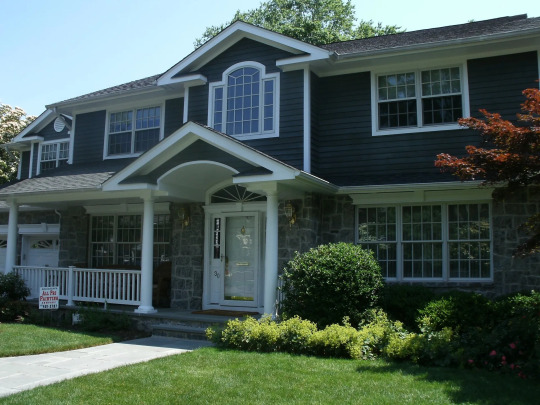
Looking for wallpaper removal Manhasset? We are the best bet at All Pro Painting Co. Get wallpaper removal Nassau completed within budget. Call today for professionals.
#Wallpaper Installation hempstead#House Painting Services Suffolk#Wallpaper Installation Nassau#wallpaper removal Manhasset
1 note
·
View note
Text
Why Roof Cleaning Ipswich Is Important
Roof cleaning can seem like a daunting task, especially for homeowners. But it is important to entrust the work to a qualified and professional house washing expert.
A dirty and soiled roof can cause several problems including water penetration, loss of energy efficiency and other structural damage to the roof tiles. These issues can be easily prevented with a regular roof cleaning service. To know more about Roof Cleaning Ipswich, visit the A Clean House Washing website or call 0419778863.
A dirty roof is not only an eyesore, but it can lower the value of a property. It can also cause water damage. The build-up of moss, algae, and lichen can lead to clogged gutters, drainage problems, and roof tile erosion. Regular cleaning will keep these problems from occurring and prevent costly repairs in the future.
A reputable Smartseal registered roof cleaner will provide a comprehensive service to remove moss, biological matter, and years of grime. The roof tiles will then be treated to repel moisture absorption, reduce heat loss, and block the growth of moss spores.
The price of a roof cleaning will vary depending on the size of the house, type of treatment, and add-ons. It’s important to know exactly what is included in the estimate before hiring a company. For example, the price should include chemicals, ladders, and other equipment necessary to complete the job. It should also include possible electricity fees and the disposal of materials like paint cans.
The harsh weather experienced in Suffolk can leave your home vulnerable to a number of issues. Your roof can be affected by things like debris and moss, particularly in shaded areas, that can damage the surface of your roofing materials. This can lead to leaks and cracks, and reduce the structural integrity of your property.
Regular roof cleaning Ipswich prevents this from happening, protecting your home and preventing deterioration of its appearance. It can also help reduce energy bills and damp penetration by stopping heat transference from the roof to the interior of your home.
An expert roof cleaning Ipswich company will only use safe, professional cleaning methods. They will not pressure wash your fascias and soffits, as this can cause damage to these vital waterproofing components. They will instead utilise a gentle, safer method such as hand scraping or Biowash (tm) non-pressure roof moss removal. This is an effective and cost-effective way to get rid of moss without damaging the tiles or guttering.
Despite the harshness of the UK climate, roofs have a tendency to become discoloured and lose their lustre. The moss, algae and fungus that grow on the surface of the tiles can damage them if they are not removed in time. This is where professional soft wash roof cleaning services come in handy.
A pristine roof enhances the overall appearance of your home and increases its value. This can be particularly important if you are planning to sell your property in the future.
Fungus, mould and mildew can leave dark stains on the exterior of your home, reducing curb appeal and causing your siding to deteriorate. Regular cleaning helps to prevent these issues and prolongs the lifespan of your home. A clean roof is also an energy efficient choice. Damp roof tiles absorb heat which can increase your air conditioning costs. A Smartseal registered contractor can apply a waterproof coating that stops heat from absorbing into your roof and reduces damp penetration by fungi, mould and algae.
It’s a costly investment to install a brand-new roof, so regular cleaning and maintenance can prevent damage and prolong its lifespan. Additionally, insurance companies often require homeowners to keep their roof clean as a condition for their coverage.
Regular roof washing removes dirt, stains, moss, mildew, lichen, and more from the surface of your roof. These contaminants cause deterioration over time, and they may lead to cracks in the tiles. They also cause leaking and moisture. To know more about Roof Cleaning Ipswich, visit the A Clean House Washing website or call 0419778863.
Roof moss removal also protects your home from increased energy bills. A clean roof reflects sunlight rather than absorbs it, keeping your house cooler and reducing the energy costs. You can further reduce your energy bills by applying a roof sealer after the cleaning process. The roof sealer will also increase the lifespan of your roof. This is especially beneficial for homes with a high resale value. Moreover, it can significantly boost the curb appeal of your property. This way, potential financiers will be more drawn to your property when evaluating it for purchase.
#house washing#home washing#high pressure cleaning ipswich#pressure cleaning#exterior cleaning#house washing ipswich#home washing ipswich#house exterior cleaning#house exterior cleaning ipswich#high pressure cleaning#roof cleaning ipswich#gutter cleaning ipswich
0 notes
Text
My Pictures for Schools - Hertfordshire
In Hertfordshire the County Council’s collection of pictures for schools was started in 1949 as part of the School Loan Collection, a post-war initiative by Sir John Newsom, the Hertfordshire Chief Education Officer at the time. The aims of Pictures for Schools were to provide education for children, show children contemporary art rather than reproductions of masters and to liven up classrooms that in post-war Britain would have needed modernisation.
Many of the pieces were purchased from reputable dealers, artists and the ‘Pictures for Schools’ exhibitions which took place from the 1950s and 1960s. I thought I would show some of the pictures I now own and put the biographies of the artists.

Vera Cunningham - 'Stooks',
Born in Hertfordshire of Scottish parentage, Vera studied painting at the Central School of Arts and Crafts. She began exhibiting with the London Group in 1922. With Matthew Smith, she exhibited in Paris at the Amis de Montparnasse and the Salon des Indépendants in 1922. Her first one-man show was held at the Bloomsbury Gallery in 1929. She produced a number of theatre designs at the end of the 1930s, but returned to easel painting. During WWII she was involved in the Civil Defence Artists' shows at the Cooling Galleries. After the war her Paris dealer, Raymond Creuze, mounted three exhibitions in 1948, 1951 and 1954. She lived in London. The Barbican Art Gallery held a retrospective exhibition in 1985. Her work is held in the Manchester City Art Gallery; the Guildhall Gallery, London and at Palant House, Chichester.
Cuningham modeled for and had relationships with fellow artists Bernard Meninsky and Matthew Smith.

Vera Cunningham - 'Garden Scene',
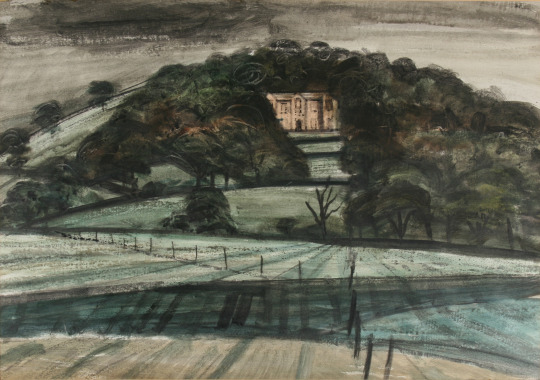
Thomas William Ward - 'Charmouth Manor'
Thomas William Ward, was born at Sheffield. Studied part-time with Eric Jones (Harold Jones's twin brother) at Sheffield 1937-1939. After service during the Second World War, Bill continued his studies at the Royal College of Art 1946-1950, winning a silver medal in 1949. He married at Kensington, London in 1949, sculptor Joan Palmer Ward. He taught at Harrow College of High Education 1950-1980, finally as principal lecturer, retiring to Suffolk in 1980. Elected a member of the Royal Society of Painter Etchers in 1953 and the Royal Society of Painters in Watercolour in 1957. This painting was bought from Whitworth Art Gallery, Manchester in 1957.

Alistair Grant - 'The Weight-lifter'
Although best known as a printmaker, Alistair Grant also painted throughout his career and in the 1980s he adopted an expressionist style using vibrant colours. He was born in London and studied at Birmingham College of Art (1941-43). After serving during the war, Grant returned to art school and the Royal College of Art, where he was taught by Carel Weight and Ruskin Spear. Grant was to work in the printmaking department of the Royal College for 35 years (1955-90), ending his career as Emeritus Professor of Printmaking at the RA.
The Weight-lifter was bought from the Whitechapel Art Gallery at their Pictures for Schools exhibition: 8 October – 29 October 1949. It is likely ‘Eva’s House’ came from a similar exhibition.
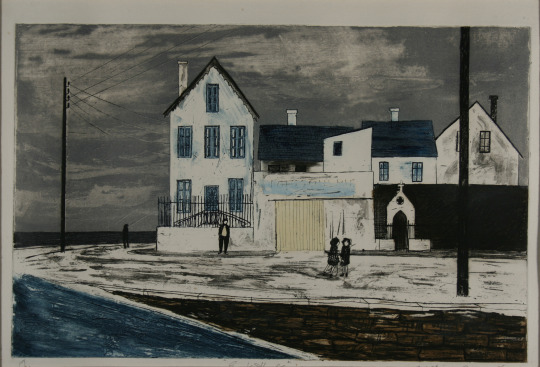
Alistair Grant - 'Eva's House', 1955

Vincent Lines - 'Old Hereford Wagon',
Vincent Lines was awarded a scholarship to the Royal College of Art in 1928. The principal, William Rothenstein described him as ‘one of the best students of the painting school’. While only in his twenties, he was appointed principal of Horsham School of Art and later became principal of Hasting School of Art. Lines was a prolific and talented topographical watercolourist, with an intimate knowledge of the countryside, which he recorded on the spot, in the open air.
He was chosen as an artist for the Recording Britain project, to which he contributed twenty watercolours. He was a close friend of Thomas Hennell and the pair often painted together in the countryside around Hennell’s home at Ridley, near Meopham in Kent.
Lines survived the war and went on to become Vice-president of the Royal Watercolour Society. He wrote the biography of Mark Fisher and Margaret Fisher Prout, illustrated Rex Waites ‘The English Windmill’
The war years brought deepened friendships in particular with Mildred Eldidge and Thomas Hennell, both fellow watercolourists of the R .W .S . Through contact with Hennell he became fascinated by country crafts and together they hunted out the potter and the cooper, wheelwright and blacksmith, hurdlemaker and charcoal burner.
During 1943-4 he painted a series of eight watercolours recording the avenues of elms in Windsor Park, before the trees were felled. The pictures are now in the Royal collection. A further commission for Vincent during these years was the contribution to Arnold Palmer’s four-volumed Recording Britain, published in association with the Pilgrim Trust.
Due to Thomas Hennell’s death in 1945 the illustration of Rex Wailes’s book The English Windmill, which would certainly have been done by him, passed instead to Vincent Lines. Wailes’s definitive survey presents English windmills in their history, construction and mode of working.
Resurgence Magazine Issue 141, Jul 1990.

Molly Field - 'Farm Implements'
Molly Field was born in Keighley, Yorkshire. She originally worked under the name Molly Clapham but then married the artist Dick Field. Attended Leeds College of Art (1932-33) then the Royal College of Art (1934-38), with Ernest Tristram. Showed at the Royal Academy, Women’s International Art Club and the Wakefield. Also known under Mary Field.
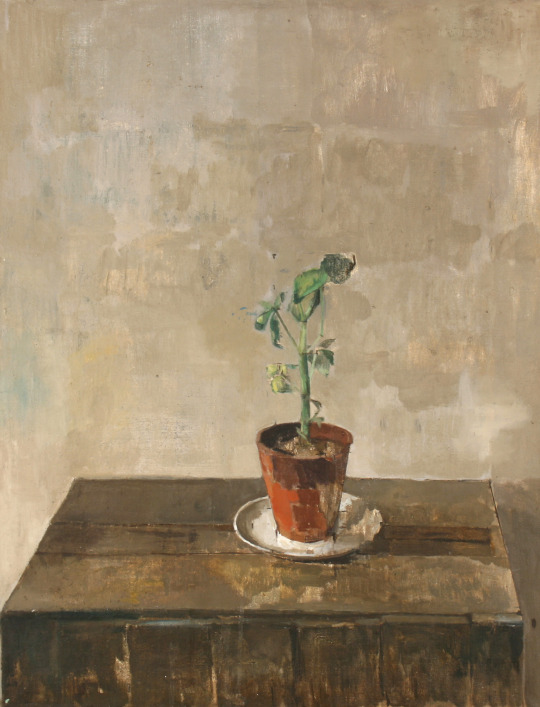
M Murphy - 'Geranium'
This is a mystery as it is one of the best paintings in the collection but there is no detail in the archives about who it is by.

Berard Gay - 'Ivy Plant'
Bernard left school at the age of 14 and after various jobs, just before the Second World War joined the merchant navy. In 1947 that he returned to education, studying textile part-time at the Willesden School of Art (1947-52) and changed course to fine-art under Maurice de Sausmarez and Eric Taylor. He began drawing classes at St Martins School of Art and quickly established himself as a painter. It may have been in the Pictures for Schools exhibition 23 January – 14 February 1954.

David Koster - 'Cat and Lilies'
Koster studied at the Slade School of Art (1944-47). Taught drawing and print-making at Medway College of Design. One-man shows at Everyman Foyer Gallery (1958, 60, 62, 64, 66, 68, 70); Glasgow Citizen's Theatre (1965); Stable Theatre Gallery, Hastings (1967). Taken several illustration commissions including work for the RSPB and a front cover for their 'Birds' Magazine.
David Koster was born in London and attended the Slade School of Fine Art from 1944 to 1947. He was a founder Member of the Society of Wildlife Artists in 1964.

Raymond Croxon - 'View in the Lake District',
Raymond Coxon enrolled at the Leeds School of Art, and the Royal College of Art. While he was there, between 1919 and 1921, he not only met his future wife but also became friends with a fellow student, Henry Moore. In 1922 Moore and Coxon visited France and met a number of artists there, including Pierre Bonnard and Aristide Maillol. Coxon continued his studies in London at the Royal College of Art between 1921 and 1925 under Sir William Rothenstein. Coxon took a teaching post at the Richmond School of Art in 1925 and in 1926 he married Edna Ginesi, with Moore acting as his best-man. Coxon would later perform the same service for Moore when he married Irina Radetsky in July 1929. He became a member of the London Group in 1931 and of the Chiswick Group in 1938.
During the WW2 he became a war artist and was commissioned to produce some paintings of Army subjects in Britain. Then working for the Royal Navy as a war artist. The painting of this print is in the collection of Palant House. The lithograph made for the Contemporary Lithographs Ltd. Other artists in the series were Eric Ravilious, John Piper, Vanessa Bell, Barnett Freedman and so on.

Julia Ball - 'East Coast Storm'
Julia Ball is a Cambridge artist and this woodcut came up for sale with the Cambridge collection of Pictures for Schools but due to a cataloguing error on the auctioneers I didn’t win it as they had labeled it as a different lot. For years I smoldered about that. But when the Hertfordshire sale came up, I had to have it. Made in the 1960s this woodcut is of a storm over the east coast. Her painting are mostly abstract and works can be found in Kettles Yard and in the New Hall art collection. This picture was bought from the Royal Academy Diploma Galleries, 1967.
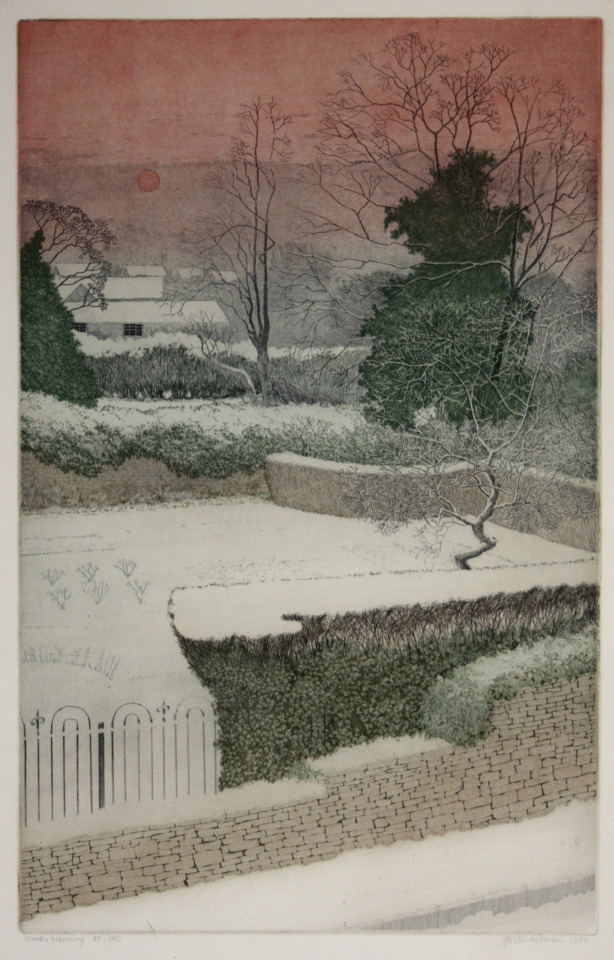
Joseph Winkelman - 'Winter Morning'
Joseph Winkelman has specialised in intaglio printmaking since 1975 after completing the Oxford University Certificate course in Fine Art at the Ruskin School of Drawing. As an active member of the Royal Society of Painter-Printmakers (RE), he served as President from 1989 to 1995 and was recently artist in residence at St John's College, Oxford.

John Sturgess - 'Black and White Leaf'
A student at the Royal College of Art in the 1950s. He would have been taught by Julian Trevelyan, Edwin La Dell, Edward Ardizzone and Edward Bawden. He worked with John Brunsdon as a printer, printing other artists work, rather than going into teaching. They set up a press in Digswell Art Centre and that is likely how his work ended up in the Hertfordshire Collection. This work of a leaf looks more like foil, it is rather beautiful and a lithograph on stone. Though I haven’t photographed it the frame is a John Jones frame made of aluminium and is as beautiful as the print.

John O'Conner - 'Boy and the Heron'
John O'Connor A.R.C.A. R.W.S, is today best known for his woodcuts, but during his lifetime he was also celebrated as a watercolourist. In 1930 he enrolled at Leicester College of Art before moving on to the Royal College of Art in 1933. His teachers at this time were Eric Ravilious, John Nash and Robert Austin. He graduated in 1937.
On a visit to Eric Ravilious’s home at Bank House, Castle Hedingham in Essex, O'Connor was captivated both by the directness of the wood-engraving technique, and by the simple domestic scene in which Ravilious engraved by a lamp in one corner of the room while his wife Tirzah played with their small son by the fire in another. It was due to Ravilious that O'Connor got his first commission of work aged 23, illustrating Here’s Flowers by Joan Rutter for the Golden Cockerel Press in 1937.
He taught at Birmingham and Bristol before serving in the Royal Air Force form 41-45. On being demobbed he illustrated two books for the Golden Cockerel Press and taught in Hastings for two years before moving to Colchester to become the head of the School of Art in 1948. He was affectionately known as ‘Joc’ to his students, using his initials. His colleagues included Richard Chopping, who designed dust jackets for the James Bond novels, his own former teacher John Nash, and Edward Bawden, one of the finest British printmakers.
He saw his favourite painting places in Suffolk - the ponds, willows, briars and honeysuckle - disappear beneath the bulldozer and combine harvester. In 1964 O'Connor retired from teaching full time at Colchester, to concentrate on painting and engraving. He wrote various 'How to’ books and taught part time at St Martin’s School of Art. In 1975 he and his wife, Jeannie, went to live by Loch Ken in Kirkcudbrightshire, where his love of light and water inspired his many watercolours and oil paintings. He took up a post teaching at Glasgow School of Art from 1977 to 1984.
In the 1950s and 60s, O'Connor exhibited at the Zwemmer Gallery, in London, and had many exhibitions throughout Britain. His work was purchased by the Arts Council, the Tate Gallery, the British Museum and the Contemporary Art Society, as well as by several local education authorities; it can also be found in the Oslo Museum, the Zurich Museum and at New York central library. He was elected to the Royal Society of Painter-Etchers and Engravers in 1947, and, in 1974, to the Royal Watercolour Society. He was an honorary member of the Society of Wood Engravers.

June Berry - 'High Meadow'
June Berry studied painting at the Slade School of Fine Art, London. She has had nineteen solo exhibitions including a retrospective at the Bankside Gallery, London in 2002. Her paintings have been exhibited frequently at the Royal Academy Summer Exhibition, London since 1952. Berry was Vice-President of the Royal Watercolour Society from 2001 to 2004.
Her work is included in the collections of HM the Queen, the British Government Art Collection, the Victoria & Albert Museum, London, the National Museum of Wales, the Royal West of England Permanent Collection, the Graphothek, Berlin, Germany and the All Union Society of Bibliophiles, Moscow, Russia. Her work has also been purchased by many private collectors in the UK, USA, Germany and Russia. She is a Member of the Royal Watercolour Society, the Royal Society of Painter-Printmakers, the New English Art Club and is a Royal West of England Academician.

Madeleine Holtom - 'Orchids'
Madeleine Elizabeth Anderson was born in Belvedere, Kent. She studied art at the Kingston School of Art where Reginald Brill was principal with other teaching from Anthony Betts, William Ware and John Platt. In 1932 she was awarded a scholarship to study at the Royal College of Art, there she won the painting prize in 1934. She painted in oils and watercolours under William Rothenstein and Gilbert Spencer.
Leaving the RCA she became a professional artist and also worked making advertisements. She married and divorced G. H. Holtom and they had two sons and two daughters, they moved to Northwood near Watford, North-West London.
She also exhibited with the New English Art Club.
Her work is represented in the collections of: Friendship House, Moscow. Queen’s College, Oxford. The Cuming Museum. Cheltenham’s Art Gallery. The Government Art Collection, British High Commission, Accra, Ghana.

Frank Freeman - 'Flower Piece',
Frank Freeman is a bit of a mystery to me at the moment. I can find mention of him in a few places but sadly due to the blitz and poor archiving many are the lost. What is known is he was supported for a while by Lucy Carrington Wertheim and he was based in the Manchester area. One flower painting is mentioned in her book Adventure in Art.
Visitors who came to see me about this time. Among these were Frances Hodgkins, who stayed for months at a time at my flat, Henry Moore and his lovely Russian wife, John Skeaping, Barbara Hepworth, Cedric Morris, Lett Haines, John Alford, William Plomer, Leon Underwood, John Gould Fletcher, Pavel Tchelitchew, Komisarieysy, David Fincham and his wife Sybil, Jim Ede and Frank Freeman.
Lucy Carrington Wertheim - Adventure in Art, 1947 p10-11

John Wynne-Morgan - 'Christmas Roses'
John Wynne-Morgan was born in Harrogate, Yorkshire and enrolled at the Heatherley School of Fine Art in London in 1945.
In a 1962 London catalogue foreword, Wynne-Morgan is described as ‘primarily a portrait painter’ (though the show contained scenes of Paris, Ibiza, Venice and London, and he also painted many Bonnard-ish nudes). His studio was in Hampstead and he was the author of three books for aspiring artists. In Oil Painting as a Pastime: A Complete Course for Beginners (Souvenir Press, London, 1959), he evokes how hard it is to embark on a portrait:

Edna Rodney - 'Parrot Tulips'
Of all the artists I bought Edna Rodney eludes me, I can not find her anywhere and it might be she was an art student who gave up art for a family or she might have been one of Hertfordshire’s pupils that ended up in the collection as sometimes happened. It is rare to find nothing however.
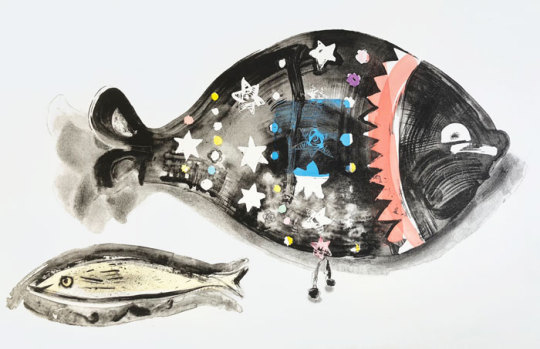
Chloë Cheese - 'Lucky Fish',
Chloëʼs childhood was spent in the Essex village of Great Bardfield observing the printmaking of her mother Sheila Robinson and she remembers in particular often visiting the studios of fellow printmakers Edward Bawden and Michael Rothenstein.
She has contributed to a recent book Bawden, Ravilious and the Artists of Great Bardfield published by the V&A. Chloë studied at Cambridge Art School from 1969 and the RCA from 1973 to 1976.
She has lived in South London since the 70s, investigating her home and surroundings first through drawing which is then used as a basis for the creation of monoprints, lithographs and etchings. Her engagement with still life subjects has widened to include figures against the palimpsest of an urban life.
Chloë has exhibited widely and her work is held in various public collections including The V and A Museum London and The Arts Council of Great Britain.
Bio via St Judes.

Chloë Cheese - 'Pink Carnations',
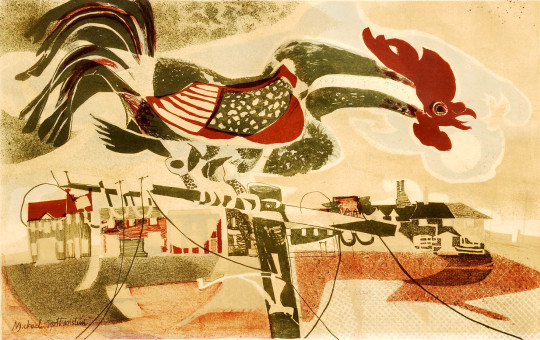
Michael Rothenstein - 'Coronation Cockerel'
Born in Hampstead, London, on 19 March 1908, he was the youngest of four children born to the celebrated artist, Sir William Rothenstein and his wife Alice Knewstub. He studied at Chelsea Polytechnic and later at the Central School of Arts and Crafts. Affected by lingering depression, Rothenstein did little art making during the late 1920s and early 1930s. Despite this, he had his first one-man show at the Warren Gallery, London in 1931.
During the late 1930s the artist's output was mainly Neo-Romantic landscapes and in 1940, like Vincent Lines, he was commissioned to paint topographical watercolours of endangered sites for the Recording Britain project organised by the Pilgrim Trust. In the early 1940s he moved to Ethel House, in the north Essex village of Great Bardfield.
At Great Bardfield there was a small resident art community that included John Aldridge, Edward Bawden and Kenneth Rowntree. In the early 1950s several more artists (including George Chapman, Stanley Clifford-Smith, Audrey Cruddas and Marianne Straub) moved to the village making it one of the most artistically creative spots in Britain. Rothenstein took an important role in organising the Great Bardfield Artists exhibitions during the 1950s. Thanks to his contacts in the art world (his older brother, Sir John Rothenstein, was the current head of the Tate Gallery) these exhibitions became nationally known and attracted thousands of visitors.
From the mid-1950s Rothenstein almost abandoned painting in preference to printmaking which included linocut as well as etchings. Like his fellow Bardfield artists his work was figurative but became near abstract in the 1960s.
Although little known as a painter, Rothenstein became one of the most experimental printmakers in Britain during the 1950s and '60s.
Rothenstein was elected an Associate of the Royal Academy (ARA) in 1977 and a Royal Academician (RA) in 1984. Near the end of his life there was a retrospective of his work at the Stoke-on-Trent City Museum and Art Gallery (1989) and important shows followed at the Fry Art Gallery, Essex.
The print I have (The Cockerel) was made for the Festival of Britain series of prints in 1951 and is signed under the mount. Likely bought from Redfern Galleries.

My blog of some of my pictures from the Cambridgeshire Collection of Pictures from Schools is here.
For areas of research I am indebted to Catherine Davis and Natalie Bradbury.
#Michael Rothenstein#Chloe Cheese#Pictures for Schools#Vera Cunningham#Alistair Grant#Vincent Lines#Molly Field#Berard Gay#David Koster#Raymond Croxon#Julia Ball#John O'Conner#Madeleine Holtom#Frank Freeman#John Wynne-Morgan
2 notes
·
View notes
Text
Greenwich Hospital, London
Greenwich Hospital was a permanent home for retired sailors of the Royal Navy, which operated from 1692 to 1869. Its buildings were later used by the Royal Naval College, Greenwich and the University of Greenwich, and are now known as the Old Royal Naval College. The word "hospital" was used in its original sense of a place providing hospitality for those in need of it, and did not refer to medical care, although the buildings included an infirmary which, after Greenwich Hospital closed, operated as Dreadnought Seaman's Hospital until 1986.
The foundation which operated the hospital still exists, for the benefit of former Royal Navy personnel and their dependants. It now provides sheltered housing on other sites.
HISTORY
The hospital was created as the Royal Hospital for Seamen at Greenwich on the instructions of Queen Mary II, who had been inspired by the sight of wounded sailors returning from the Battle of La Hogue in 1692. She ordered the King Charles wing of the palace—originally designed by architect John Webb for King Charles II in 1664—to be remodelled as a naval hospital to provide a counterpart for the Chelsea Hospital for soldiers. Sir Christopher Wren and his assistant Nicholas Hawksmoor gave their services free of charge as architects of the new Royal Hospital. Sir John Vanbrugh succeeded Wren as architect, completing the complex to Wren's original plans.[1]
An early controversy arose when it emerged that the original plans for the hospital would have blocked the riverside view from the Queen's House. Queen Mary II therefore ordered that the buildings be split, providing an avenue leading from the river through the hospital grounds up to the Queen's House and Greenwich Hill beyond. This gave the hospital its distinctive look, with its buildings arranged in a number of quadrants. Its four main buildings (the "Courts") are bisected north-south by a Grand Square and processional route, and east-west by an internal road from the East Gate (and gate-house) to the West Gate (and gate-house) by Greenwich Market in Greenwich town centre. The Grand Square and processional route running north-south maintained access to, and a river view from, the Queen's House and Greenwich Park beyond.[2]
Construction was financed through an endowment, financed through the transfer of £19,500 in fines paid by merchants convicted of smuggling in 1695, a public fundraising appeal which brought in £9,000, and a £2,000 annual contribution from Treasury. Parliament passed the Greenwich Hospital, etc. Act 1695 (7 & 8 Will. 3 c. 21), long titled An Act for the Increase and Encouragement of Seamen, which established the basic rules of use and benefits for seamen,[3] and amended it the following year by the Greenwich Hospital, etc. Act 1696.[4] In 1705 an additional £6,472 was paid into the fund, comprising the liquidated value of estates belonging to the recently hanged pirate Captain William Kidd.[5]
The first of the principal buildings constructed was the King Charles Court (the oldest part dating back to the restoration), completed in 1705. The first governor, Sir William Gifford, took up office in 1708.[6]
The other principal buildings constructed included Queen Mary Court (planned by Wren and Hawksmoor, but not built until after Wren's death, by Thomas Ripley), completed in 1742, Queen Anne Court (architects: Wren and Hawksmoor), and King William Court (designed by Wren, but completed by Hawksmoor and Sir John Vanbrugh).[7]
Queen Mary Court houses the hospital's chapel (designed by Wren but not completed until 1742). Its present appearance dates from 1779–89, when it was rebuilt to a design by James "Athenian" Stuart after a devastating fire. King William Court is famous for its baroque Painted Hall, which was painted by Sir James Thornhill in honour of King William III and Queen Mary II (the ceiling of the Lower Hall), of Queen Anne and her husband, Prince George of Denmark (the ceiling of the Upper Hall) and George I (the north wall of the Upper Hall). The Painted Hall was deemed too magnificent for the pensioned seamen's refectory and was never regularly used as such. It became a tourist destination, opened for viewing. On 5 January 1806, Lord Nelson's body lay in state in the Painted Hall of the Greenwich Hospital before being taken up the river Thames to St Paul's Cathedral for a state funeral. In 1824 a National Gallery of Naval Art was created in the Painted Hall, where it remained until 1936, when the collection was transferred to the National Maritime Museum, newly established in the Queen's House and adjacent buildings.[8]
On the riverside front of the north-east corner of King Charles Court is an obelisk, designed by Philip Hardwick and unveiled in 1855, erected in memory of the Arctic explorer Joseph René Bellot, who died in an unsuccessful attempt to rescue the members of John Franklin's ill-fated expedition to open a Northwest Passage in northern Canada.[9]
A Royal Hospital School opened on the site in 1712 to provide assistance and education to the orphans of seafarers in the Royal and Merchant Navies. In 1933 it moved to Holbrook, Suffolk (where it remains today); the old school buildings were reopened the following year as the National Maritime Museum.[10]
The Greenwich Hospital buildings included an infirmary, constructed in the 1760s to a design also by James Stuart,[11] where pensioners were attended by trained medical staff (Sir John Liddell was for a time senior medical officer). After some adaptation and rebuilding this became the Dreadnought Seamen's Hospital in 1870 (taking its name from a hospital ship moored off Greenwich). The treatment for tropical diseases moved in 1919 to the Seamen's Hospital Society hospital near Euston Square, in central London, to form the Hospital for Tropical Diseases. The Dreadnought Seaman's Hospital closed in 1986, with special services for seamen and their families then provided by the Dreadnought Unit at St Thomas's Hospital in Lambeth.[12]
Greenwich Hospital closed in 1869. The remains of thousands of sailors and officers, including many of those who had fought in the Battle of Trafalgar, were removed from the hospital site in 1875 and reinterred in East Greenwich Pleasaunce also called Pleasaunce Park (named after the former Palace of Placentia which had been on the site of the hospital).[13]
https://en.wikipedia.org/wiki/Greenwich_Hospital,_London
2 notes
·
View notes
Text
This slideshow requires JavaScript.
1. A home frozen in time
An enchanting time capsule, the Marion Carll Farmhouse on Long Island has lain empty for years due to a lack of funding and a legal battle over ownership rights that has only just been resolved. Photographer Bryan Sansivero was granted exclusive access by the local school board and district to capture the beguiling Victorian property before its many antiques and curios were removed. Take a peek around the house that time forgot and transport yourself to a bygone era.
2. A faded beauty
Located in the hamlet of Commack in Suffolk County, New York, the nine-acre farmstead dates way back to 1701, while the clapboard farmhouse was built on the eve of the Civil War in 1860. The property takes its name from long-time resident Marion Carll, who was born in 1885.
3. A pillar of the community
Marion Carll was a renowned teacher who taught in the local district and went on to found the area’s first PTA and had a grammar school named after her in 1957. When she died in 1968, she bequeathed the house to the Commack School Board and District with the proviso that it should only be used for educational and historical purposes.
4. A fight for ownership
Occasional classes were offered by the Boards of Cooperative Educational Services (BOCES) but abandoned in the 1990s due to a lack of funding. Since then, the house and surrounding farm have been left vacant. In 2012, Ms Carll’s descendants launched a legal battle with the school board and district which they accused of failing to adhere to the conditions set out in their ancestor’s last will and testament.
5. Period details
A New York State Supreme Court judge recently ruled that the school board and district has a right to retain ownership of the property, ending the protracted legal battle. You can see why they fought over this house. Though crumbling, it still boasts oodles of period charm. Ms Carll was clearly keen to preserve its 19th-century allure and did little if nothing during her lifetime to modernize the farmhouse, which is resplendent with fine antiques and interesting curios.
6. The parlor
Talk about a time warp home! The parlor contains some wonderfully evocative pieces including this ornate piano by New York City company Calenberg & Vaupel. The firm first started making musical instruments in 1864, four years after the farmhouse was constructed
7. Antique medicines
Empty bottles that once contained all sorts of curious concoctions abound in the farmhouse. Note the bottle of paint-stripping potion Pyranzine and the container labeled ‘Laudanum’, a super-potent and extremely addictive tincture of opium that was used to treat pain.
8. Untouched rooms
Although covered in thick dust, the house looks as if she has just left the room. Here, her old sewing machine sits ready for use in what would be a bright spot by the window, if the blinds were open.
9. Locked-up riches
Ms Carll secured her valuables in a safe manufactured by the famous Hall’s Safe Company. The firm, which was established during the mid 19th century in Cincinnati, makes some of the finest safes and locks in the world and is still going strong today.
10. Original features
Beautiful marble fireplaces adorn the rooms in the farmhouse, and though the wallpaper is peeling off, the property’s original features, including the door frames and skirting boards, are in remarkably good condition.
11. Decorative flourishes
Charming touches pervade the property. They range from delicately embroidered cushions and blankets to exquisite china pieces and this enamel chamber pot filled with fabric flowers.
12. A family home
Photographs of the Carll family are captured here scattered on a table in the farmhouse. As you can see from the classy clothing they are sporting, the family members appear to be comfortably well-off and exceedingly genteel.
13. The ravages of time
While some areas of the house look to be in a reasonable state, others are obviously dilapidated and in dire need of restoration work.
14. A snapshot of the past
Education was Marion Carll’s vocation and passion, so it comes as no surprise that the much-loved teacher owned a writing bureau, in front of which she no doubt sat for hours composing letter after letter and marking her students’ work.
15. The dining room
The dining room is just as well-appointed and elegant as the other rooms in the farmhouse. A solid wooden table takes pride of place in the center, while an imposing cabinet off to the side showcases the family’s fancy china and glassware.
16. Some mod cons
The odd relatively modern touch can be found in the house including this attractive Art Deco fan, which contrasts with the Victorian and early 20th-century objects that are dotted around the property.
17. Retro remedies
Another curious bottle in this shot: Humphrey’s “30”, a homeopathic remedy to help prevent incontinence and bed-wetting. Intriguingly, the classic concoction is still available these days and can even be snapped up from Amazon.
18. The farmhouse dresser
This dresser in what appears to be the farmhouse kitchen contains the family’s day-to-day crockery. The chinoiserie Blue Willow pattern was hugely popular in America during the late 19th century and throughout much of the 20th century.
19. Prints from the past
The walls of this room are decorated with several historical prints including a copy of John Trumbull’s iconic Declaration of Independence, which was painted in 1818 and features on the two-dollar bill.
20. Antique furnishings
This photo shows what looks like the bathroom or washroom of the farmhouse. Note the white clapboard walls so typical of nearby New England, as well as the fancy gilded mirror and old-style water pump.
21. Old lace
The master bedroom contains a box of sewing threads and a dressmaking dummy covered with an exquisite lace piece that was presumably hand-tailored by Ms Carll herself.
22. A picture of neglect
This wider shot of the master bedroom shows exactly what years of vacancy and neglect can do to a property that was once meticulously maintained. Paint is peeling off the walls, while the floor and furniture are littered with debris.
23. A 1930s timepiece
Another Art Deco piece, this wind-up Ingraham Meteor alarm clock was manufactured in 1936. It sits next to a dusty empty bottle of C. C. Parsons’ Household Ammonia, an essential cleaning product from way back when.
24. Faded fashions
More dressmaking paraphernalia in this room. Against those starkly cracked walls, this space has a rather dramatic and eerie feel. The dummy is dressed in a corseted bodice and cage crinoline which was used to support the elaborate skirts and bustles of 19th-century dresses.
25. A simpler way of life
This evocative shot shows a chest of drawers that was used as a wash table. Age-old toiletry products feature on the tabletop alongside a jug, bowl and antique towels for daily ablutions.
26. Dancing days gone by
A pair of black ballet-style shoes, which may have been hand-embroidered by Marion Carll or another member of the family, lie on one of the linen-covered beds in the property, placed next to two fabric roses.
27. A glimpse into history
Peering into the long hallway on the upper floor of the farmhouse, you can’t help but notice how rundown parts of the property have become. This wing of the house was used to accommodate slaves before the abolition of slavery in 1865, thereafter it served as the servants’ quarters.
28. A vintage tableau
In contrast to the long hallway, this bedroom is in fairly good shape and doesn’t look like it would need much more than repapering to restore it to its former glory. Silk dresses, straw hats and ballet shoes pack the closet, along with a pretty parasol.
29. The attic
The attic room looks like it was once used for storage or perhaps sleeping quarters for domestic staff. Damp stains the ceiling and a number of rusty old cage crinolines hang from wooden hooks on the wall.
30. A grand inheritance
The beauty of this time capsule home, but for now at least the gates remain closed on the property while the Commack School Board consult the community on its fate. Options include turning it into a public park, a working organic farm and creating an education center, all in the spirit of Marion Carll’s wishes.
Originally Posted on: https://gayle61.blog/2019/04/27/step-inside-this-abandoned-old-house-untouched-for-40-years/
A step inside the Marion Carll Farmhouse 1. A home frozen in time An enchanting time capsule, the Marion Carll Farmhouse on Long Island has lain empty for years due to a lack of funding and a legal battle over ownership rights that has only just been resolved.
3 notes
·
View notes
Text
Here We Go Again: Satanic Graffiti In Amityville (By Magus Peter H. Gilmore)
This morning I awoke to news stories proclaiming that three churches located in North Amityville in Suffolk County on Long Island were vandalized with SATANIC GRAFFITI. Apparently, some time Saturday night, a vandal scrawled on the external walls of the Amityville Full Gospel Tabernacle, the Shaw Temple AME Zion Church, and the Zion Gospel Church, all close to one another. Oddly, none of the major news reports, which include ABC’s Eyewitness News account, show any of the graffiti. However, it was explained in other reports that the offending graffiti was painted over before the Sunday morning services. I did find one image posted online in the past few hours of an upright pentagram in a circle painted on a set of double doors. The footage shown on ABC, including an interview with Pastor Willard Price of the Zion Gospel church, includes an image of doors that may be from the same building, but the graffiti had already been overpainted. The report states that the police are calling this “satanic graffiti” and that it is being investigated as a hate crime.
During my search for additional images of this so-called “satanic graffiti,” I discovered a report that there had been another vandalism incident five days ago in East Meadow Long Island—roughly ten miles west of last night’s crime—which was being labelled the same way. CBS News reported that the New Covenant Church of East Meadow was vandalized with “satanic worship symbols.” Their pastor, Rob Taormina, states in an interview that “if somebody came and painted your house up with satanic symbols I think you’d be disturbed, too, ‘cause you don’t know who they are and you [don’t] know if they’d come back.” In this case, a glass vestibule door was smashed as well.
I’ve long been a consultant for law enforcement, assisting during investigations of crimes using unusual symbols, and I’ve not yet been called in on either of the incidents mentioned above. However, upon examining the news story images, what stands out to me immediately is that in both towns a form of pentagram was drawn which has one point up. This is not a symbol used in either Satanism or Devil worship—where two-point-up pentagrams are employed—but is found in the neo-pagan religion of Wicca in its various forms. The East Meadow images show inverted crosses and the word “Satin” which shows that the writer is either illiterate, or into shiny fabric. Also the words “DEVIL, WITCH, SPELL, CURSED” as well as a “frowning face” emoji are crudely inscribed.
Now, if the criminal doing this vandalism was actually knowledgable about Satanism or Devil worship, then I think the pentagrams would be the proper sort, not the neo-pagan version we see here. Also the incorrect spelling of “Satan” and simply the use of terms popularly associated with witchcraft lead me to think that the person who did this is most likely a Christian who is going by fairly typical misprisions regarding these non-Christian religions. This hateful person wanted the people attending these churches to feel that this crime was done by an adherent of Satanism, Devil worship or some form of witchcraft involving reverence for The Devil—like you see in horror films or in those books published by evangelical Christians which spread grave misinformation about non-Christian religions.
This sort of thing was common during the years of the “Satanic Panic” back in the 80s-90s, wherein similar graffiti—often accompanied by “666” and symbols used by various anti-Christian metal bands—was found on building walls and under bridges and so on. Back then, such things were likely done by metal fans who shared the anti-Christian biases of the bands they followed or by disaffected youths dabbling in the sort of “satanism” they saw being depicted by the media as a form of rebellion. We deal with the meaning of 666 and other symbols on our web site.
These two recent incidents look more to me like they were done by a Christian who wants people to think that somebody associated with a religion employing these symbols has a grudge against these churches. It is clear to me that, whether Christian or not, the perpetrator is ignorant of Satanism, Wicca, and Devil worship. Whatever hatred is in the mind of this criminal, the deed was done by someone who is not an adherent of Satanism, Devil worship or Wicca, and simply wants to blame their own anger on these other religions while terrorizing the congregations of these churches.
Even when vandals do use symbols that reflect Satanism, since we have a philosophy that does not condone criminal actions it should be clear that anyone committing such crimes is not a Satanist, or if self-identified as such is acting in a manner contrary to our belief system. This article from 2008 covers this topic rather well.
Considering the past lunatic obsession with a manufactured conspiracy of predatory “satanists” out to get people, it is incumbent upon both law enforcement and the media not to jump to unwarranted conclusions by proclaiming this is “satanic graffiti” when Satanism is not its source. The Church of Satan is a 50 year old, legally incorporated religious organization with members worldwide who abhor this sort of crime. We’ve been through one hysteria—begun by evangelical Christians and taken up by misinformed law enforcement agencies and sensationalist media outlets—that caused harm to many innocent people. We do not want to see that madness rising again, abetted by uninformed or biased forensic analysis and reportage. I trust that this vandal will be apprehended via diligent police work based on an accurate grasp of the deeds done and receive due punishment for these crimes.
#satan#satanism#the church of satan#satanist#lucifer#peter h gilmore#antonlavey#satanic#anton lavey#leviathan#peggynadramia
23 notes
·
View notes